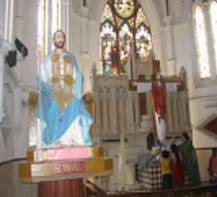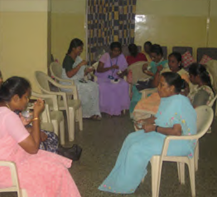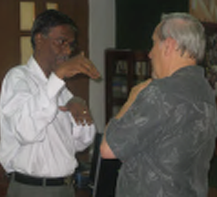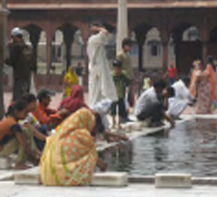India
It was a ‘privilege of a lifetime’ to offer the Art of Living & Dying series in several locations throughout India. Richard Groves worked with local communities and health care universities who are establishing hospices for the poorest of the poor.
Lessons And Reflections From India
Richard Groves
“Life is like a book and the person who has never travelled has only read one page…” — St. Augustine
This quote is emblazoned on a large banner inside the airport terminal in New Delhi, India.
Every year, Sacred Art of Living Center offers a program series in a Third World location or— where there are severe financial limitations. We see this as our annual organizational “tithe.” Since our foundation in 1997, Mary and I made a conscious commitment to not exclude deserving students based on tuition alone. We also believe that the nature of our work demands global solidarity.
This is by no means a one-sided blessing. Each international experience enriches and expands the horizons of our teaching in the sacred art of living and dying. Our recent trip to India was another remarkable adventure in mutual learning and cultural exchange. Thanks to a grant from ELCA’s global mission in Chicago, programs and introductions to the Sacred Art of Living & Dying series were offered in the summer of 2009 in the cities of Chennai, Vellore and New Delhi, India. Here are a few stories, pictures and highlights–




Sacred India
India is indeed sacred ground. A land of unparalleled cultural and spiritual diversity, several of the world’s great religious traditions were born here centuries ago. I am grateful that before beginning several days of teaching, my hosts introduced me to some special places beginning at the shrine of Thomas the Apostle in the ancient city of Madras (now Chennai). According to legend, Thomas traveled to the Indian subcontinent in the first century after Christ and brought with him many remarkable teachings about the art of living and dying. I was re-introduced to the Gospel according to Thomas which, although not officially considered a scripture, is a remarkable bridge between Eastern and Western perspectives on the nature of suffering. A bishop at the shrine affirmed our work in India saying that it echoed Thomas’ 2000 year old teaching about ending suffering by entering into our pain. It was also in Chennai that I was introduced to the teachings of a venerable Indian teacher, Swami Veda Bharati. His book, Meditation and the Art of Dying communicates what has been taught by the Himalayan sages and the teachers of the Vedic tradition for more than 5,000 years. Here is a story related by Veda Bharati that moved me deeply–
In the nineteenth century, there was a great man named Swami Dayanand. In India, he is considered a great reformer and is even compared to Martin Luther. He was responsible for getting rid of a lot of religious superstitions and prejudices in the society of his time. But because of his outspoken behavior and extraordinary spiritual strength, he was a threat to the establishment of his day and there were many attempts on his life.
There was a young man, well versed in the Western sciences of the time, who would come to argue with him about the existence of God. This young man, Gurudatt, would question and argue with the yoga day after day but finally said, “Master, you have closed my mouth with your arguments. I have no more questions, but still, somehow, I cannot accept the existence of eternal life or of God. I do not feel faith in me.” The Swami answered, “That is not for me to give. That is God’s own gift of grace to offer when the time is right for you.”
One day the yoga’s very own servant and cook who was heavily bribed poisoned the swami’s meal who was unable to expel all the tiny pieces of crushed glass that were mixed with his food. He realized that the time had come for him to leave his body and the word went out that the master was dying. It happened to be a special day in India called the Celebration of Lights.
The swami took his bath as is the custom, sat in the lotus posture, and told everyone to leave the room. However, the young, argumentative Gurudatt hid behind the window curtain and witnessed the entire scene of the swami preparing for his death in such a careful yet casual manner. He saw his master sit and recite the chant, OMMMMMM, Peace, peace, three times. Then he saw him laugh, then smile, then take a final deep breath, expel it, and die.
From that moment on Gurudatt had no more arguments, no more questions and no more doubts.
I believe that this story was given to me as a sacred gift that prepared my own spirit for the days of teaching ahead.



Hospice In India
There is not a person in India who does not know about Mother Theresa of Calcutta. Her work with the poorest of the poor helped to create a selfless legacy of end-of-life care that continues to grow worldwide. While visiting different foundations of her Missionaries of Charity, I witnessed how remarkably broad her vision has become—including the care of the untouchable class and children with every kind of handicap.
We were housed at one of India’s newest hospice facilities in the southernmost state of Tamil Nadu. The “Sneha Deepam Hospice” (meaning, “the flame of love”) is a state-of-the-art facility treating patients regardless of belief, disease or need. Each morning there was an opportunity to pray with the patients who represented many different belief systems. I was especially impressed by the new chapel which included stained glass windows of all India’s great religious traditions—it was a vision of what it means to be ‘catholic’ in the best sense of the word.




Redefining The ‘Home’ In Home Healthcare
By contrast, I also traveled with a palliative care team to some remote villages where hospice patients were being cared for ‘at home.’ Home meant a grass hut with dirt floors and no plumbing or electricity. I don’t think anything else left as deep an impression on me as these home health visits. In situations of the most extreme poverty, I was inspired by a bit of wisdom that kept being repeated as a kind of prayer by Hindu patients and their families. In the ancient Indian Tamil language, it reads:
![]()
“Whichever way God would let me go.”
I have rarely encountered such ego-lessness and surrender in the face of suffering. The question arose in me: How is it that from the soil of physical and material poverty, the human spirit blossoms so beautifully? India has challenged me to revisit the geography of the beatitudes, “Blessed are the poor in spirit…”




Teaching In India
A full two-day Sacred Art of Living & Dying program was presented at one of India’s largest and most respected medical centers. The CMC (Christian Medical College) of Vellore was founded over a hundred years ago by an American-Indian physician, Dr. Ida Scudder, who had a special vocation to care for the needs of underserved women in her time.
I soon realized how spoiled I was when the hospital auditorium had no air conditioning and the temperatures in India hit a record 54 degrees Celsius (130 F) during our stay! Combine that with some of the spiciest food I have ever eaten and I lost about fifteen pounds of weight during my two-week trip—which was not a bad thing! In spite of these physical inconveniences, the hospitality and energy of the staff and participants were second to none.




Our sponsoring team in India included John Lund, an American nurse, chaplain, and hospice visionary in India, Dr. Reena George, the medical director of the Vellore palliative care program, and Mr. Hamilton I, a native social worker and soon-to-be pastor. The program was attended by a spectrum of students that included nurses, physicians, chaplains, and other members of the community.
Evaluations from the class were gracious and humbling. The notion of ‘Anamcara’ struck a deep chord among the participants who were fascinated by the program ritual and the entire process. Since the Celtic languages are Indo-European in origin, it was not lost on the class that many of the traditions we spoke about may well have had their origins in India millennia ago. It is our sincere hope to return and complete the entire Sacred Art of Living & Dying series.
Part of international teaching is the privilege of encountering extraordinary people and their stories. A well-known social activist attended our class who had just been released after spending two years as a political prisoner. Dr. Binayak Sen is a pediatrician, public health specialist and national president of the People’s Union for Civil Liberties (PUCL) based in India’s Chhattisgarh state. His release marked India

Dr. Binayak Sen with Richard Groves
and Dr. Reena George in Vellore, India

Supreme Court’s shortest case—lasting just minutes. Binayak brought a genuine luminosity into the classroom that was perceptible. He carried in his person the lessons of the sacred art of living and dying– recently suffering so much and yet totally at peace.




Healing The Healers
A special presentation of the sacred art of living and dying was offered at Chennai’s Gurukul or seminary. Clergy and religious leaders from many denominations attended a program on the ministry of suffering. I am still trying to discern what it was about this remarkable group of women and men that was so special. The program included a presentation but also centered around an open forum on issues related to faith, religion and culture in India today. Christianity is only about 4% of the Indian population and those in attendance named many of the same challenges that pastors face in North America. On the other hand, there was a remarkable humility that shone through both their questions and lives. It was evident that persons who had chosen this path of life were not endowed with clerical privileges or special status and material comfort. Several times during our forum, I could barely keep from crying in the face of a very pure AND selfless approach to service and ministry. Is this the result of being a minority or from living without the expectation of material reward? I still carry their faces and stories with me.


On A Lighter Note
I was very lucky to have had a travel partner in India. My 23-year-old grandson, Jim, accompanied me and did everything from hauling program materials to running electronics, facilitating program rituals and just being a great companion. I promised Jim that after our teaching trek, we would take a side trip to Agra, the site of the Taj Mahal. It was an exotic journey, complete with every stereotype you may have ever had about India—monkeys, elephants, cobra snake charmers, and unbelievable crowds of people.
India is the world’s second most populous country (1.3 billion people). Jim is a university student who is majoring in Abrahamic religious studies. Visiting India’s largest mosque was a special highlight for him as well as the inseparable Muslim history behind the famous ‘taj.’ As the crowd was gathering for Friday prayer, a young man, not more than 16 years old, asked if we were Americans. I said yes, and he gave me a ‘thumbs up’ saying he prayed that Americans and Muslims might find peace again.
We bought a few souvenirs for future Sacred Art of Living Center programs at a craft store operated by a Kashmiri family. We ended our trip with a visit to one of New Delhi’s magnificent Hindu Shrines dedicated by Gandhi as the first temple open to every caste of Indians. Over the door of the temple was a Sanskrit quote from the Baghavad Gita: “The friend of the self is the self, the enemy of the self is the self; only the self can redeem the self.” Our forty-eight hour trip home gave us stories and impressions to share for a lifetime!




